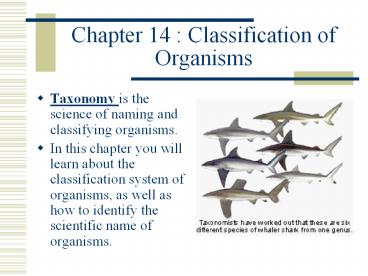Chapter 14 : Classification of Organisms PowerPoint PPT Presentation
1 / 11
Title: Chapter 14 : Classification of Organisms
1
Chapter 14 Classification of Organisms
- Taxonomy is the science of naming and classifying
organisms. - In this chapter you will learn about the
classification system of organisms, as well as
how to identify the scientific name of organisms.
2
Scientific Names
- Every known organisms is given a scientific
name. These names are in latin and represent the
genus and species of the organism. - Using two names to identify an organism is known
as binomial nomenclature.
3
Scientific Names
- A scientific name capitilizes the genus and lower
case is used for the species. Both the genus and
species are written in italics. - Homo sapiens - you
4
Classifying Organisms
- Carl Linnaeus arranged for a system of
classifying organisms which uses different groups
or taxa. - The form and structure of an organism is used to
determine to which groups or taxa it belongs to.
5
Groups Domain
- All living things are grouped into one of three
domains - Archaea prokaryotic
- Bacteria prokaryotic
- Eukarya eukaryotic cells
Archaea bacteria which live in extreme
environments
6
Groups
- The following are the modern groups in which
organisms are classified into - Domain
- Kingdom
- Phylum
- Class
- Order
- Family
- Genus
- Species
7
Kingdoms
- There Eukarya Domain is divided into 4 Kingdoms
- Animalia animals
- Plantae plants
- Fungi mushrooms, etc.
- Protozoans/algae small organisms
protozoans
8
Kingdom Animalia
- The animal kingdom is divided into 9 smaller
groups called phylas. - Each phyla is divided into groups called classes.
- Classes are divided into smaller groups called
orders, orders divided into families, families
into genuss, and finally the species.
9
Classification
- Organisms are then classified based upon their
structures and similarities. - The species is the basic unit of classification.
10
How Biologists Classify
- Biologists define a species as a group of natural
interbreeding populations. - Species are classified as to their cellular
structure, and overall structure, as well as
their populations.
11
Classification Criteria
- Classification of a species also uses its
evolutionary history (phylogeny). - Cladistics is a method of analysis of similar
species in the past. A cladogram compares similar
species and changes from the fossil record of the
past.

